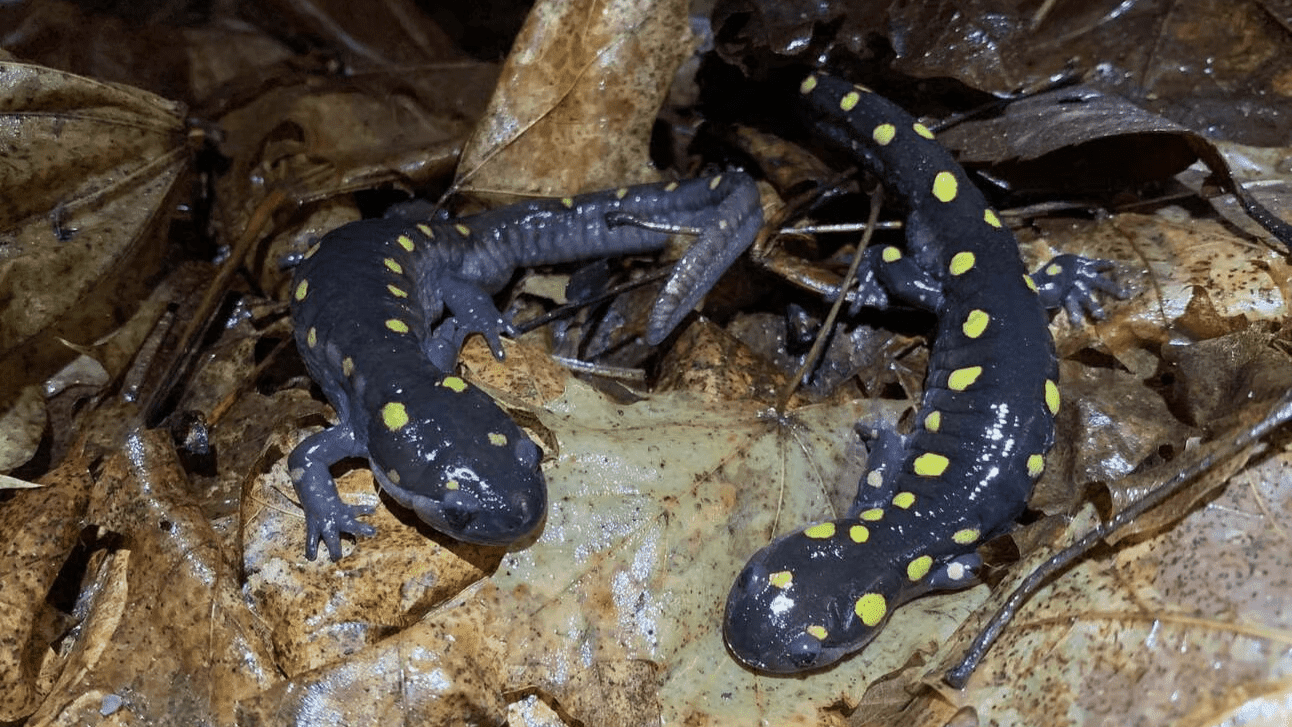On a cold, drizzly night in early spring, Bridget VerVaet posed a question to the Maine Big Night – Amphibian Migration Monitoring Facebook group: why were there so many dead Spotted Salamanders near the Butler Head Preserve in Bath?
Some had been crushed by cars, but others seemed to have no visible injuries — no bloating or other obvious trauma. It hadn’t been unusually cold, and tracks indicated that the salamanders had perhaps walked in circles before perishing. Some were “squished together, like they had died on top of each other or at least right next to each other?” VerVaet noted. “Really weird signs of odd behavior.”
Greg LeClair, the founder of the Maine Big Night project, responded quickly. “Woaaah something is wrong here,” he wrote. It wasn’t the first time he’d seen mass die offs of amphibians as part of the project, in which volunteers monitor the migration of salamanders, frogs and other amphibians from winter hibernation spots to breeding grounds each spring.
He’d seen salamanders frozen after being caught in bad weather, but it hadn’t been that cold. After reaching out to biologists with the Maine Department of Inland Fisheries and Wildlife, LeClair learned similar salamander die offs had been reported in Bangor and Frankfort that spring. The three spots had one thing in common: they were all on dirt roads, in areas that had seen little rain.
“Salamanders, for some reason, were suddenly being found in these mass die offs on dirt roads — a dozen to several dozen dead, for just no reason,” said LeClair last week.
Scientists have yet to definitely say what killed the tiny spotted creatures, but their best guess, said LeClair, is that a dry spring meant that a de-icing chemical, possibly calcium chloride, was sticking around longer than usual, resulting in higher than normal concentrations of the chemical in some spots. “If they’re crossing these dirt roads while it’s still in high levels they might actually be getting killed by it,” said LeClair.
Road salt is one of those essential but oft-overlooked aspects of modern life in Maine. Without it, we’d have a far harder time getting where we need to go in the winter, and it would likely be much more dangerous and take a lot longer. We’ve come to expect being able to drive on clear roads at posted speeds soon after storms, and road salt is one of the most efficient, cost-effective ways we know of to help keep roads clear and safe.
But all that salt has to go somewhere — and because there is no natural process by which chlorides break down, much of it ends up in the surrounding environment, including in our lakes, ponds and groundwater, where it can take decades to dissipate.
A 2008 study found that road salt had contaminated vernal pools as far as 564 feet — nearly 1.5 football fields — away from highways. Maine, a rural state with more miles of roadway per person than anywhere else in New England, applied 23,510 pounds of road salt (mostly sodium chloride, but calcium chloride and other chemicals are also used) per lane mile of road in 2019-2020, or roughly 787 pounds per person.
There are ways to minimize salt washing into habitat — simply wetting the mixture before it’s applied dramatically reduces the amount that winds up in the ditch. MaineDOT pre-wets its salt, but most municipalities don’t, or don’t very often, according to a 2022 assessment of statewide road salt practices done by researchers at the University of Maine. Scientists are also looking into alternatives, including de-icers made from beets, flower residue and even cheese brine, but most are expensive and not as effective as road salt.
This isn’t the first time Big Night volunteers have found evidence of road salt harming amphibians. A few years ago the group picked up a number of Wood Frogs, some alive, some dead, with massive, swollen sides — the result, it turned out, of edema caused by the chemical.
Overall, however, cars remain the bigger problem. Of the 5,240 amphibians recorded by Big Night volunteers at 189 sites around the state this spring, most of the 1,241 of them (24%) that died were hit by cars.
That mortality rate is actually low, said LeClair — most years it’s closer to 30%. There could be several reasons for the drop, including volunteers surveying at times when traffic was low. “We’re actually almost to pandemic shutdown levels of mortality,” said LeClair, when there was far less traffic on the roads. Northern Leopard Frogs, a species of state concern, had the highest mortality rate this year — 44% of the 43 frogs were found dead.
The three deadliest sites for amphibian crossings in 2023, according to Big Night data, were Durham Road in Brunswick, Forest Avenue in Orono and Boyd’s Corner Road in South Berwick. The group has compiled a list of the top 30 sites most deserving of some type of crossing structure, a list based on a variety of factors, including how many amphibians have been recorded there, how many were found dead and what type of species have been seen.
“It seems like every year we pick up a new phenomenon.”







